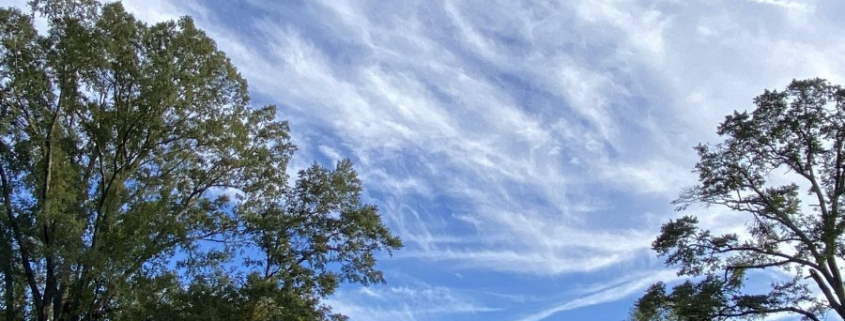Eufaula, Alabama — A Certified Sustainable Community Since 2000
I visited Eufaula, Alabama the afternoon of October 13, 2022, while in the area exploring Alabama’s Lakepoint State Park and the Eufaula National Wildlife Refuge. I present photographs, reflections, and observations from a brief hike on the Yoholo Micco Trail. In addition, with assistance from Ron Dodson, long time friend and fellow Nature-enthusiast, we offer a retrospection on our Eufaula Sustainable Community project that Ron initiated and led 20+ years ago.
I had last been to Eufaula during my tenure as Director, Alabama Cooperative Extension System (ACES; 1996-2001). Although ACES had offices in all 67 Alabama counties, the Barbour County seat holds special memories for me. The County Extension Director alerted me that a gentleman I should meet was in town discussing with County officials a project that would spark my interest. He arranged for me to meet with Ron Dodson, then Executive Director of Audubon International. Ron and I have remained close professionally since then.
I recalled the project that recent October evening when I hiked the Yoholo Micco Walking Trail along the western shoreline of Lake Eufaula. I wondered whether the relatively new trail emerged from Ron’s vision and efforts two decades ago. Allow me to share some of the trailside images with you as Ron and I together reflect upon the project he led in concert with community leaders and citizens, including local ACES staff, two decades ago.
Eufaula Sustainable Communities Program 2002
From a 2002 report that Ron recently shared with me, laying the groundwork and context for a program that could model an approach to community sustainability:
In 1997, Audubon International was invited to Eufaula, Alabama, to discuss the possibility of becoming the first Audubon Cooperative Sanctuary Community. To that end, Audubon International embarked on an effort to develop a community-wide environmental stewardship program. The city of Eufaula adopted the guiding principles and environmental practices of Audubon International’s Principles of Sustainable Resource Management. Community volunteers, including city officials and community and business representatives, formed a steering committee to spearhead the education outreach initiative called “Sustainable Eufaula.” The purpose of Sustainable Eufaula was to encourage community-wide participation in the Audubon Cooperative Sanctuary System programs to help educate, promote, and involve the entire community in stewardship activities. “Sustainable Eufaula” led the way to the creation of Audubon International’s Sustainable Communities Program, currently going through a second round of pilot testing. The City of Eufaula, located in southeast Alabama, has a population of about 15,000 people, and comprises about 70 square miles. It is part of the Southern Coastal Plain natural region, which is characterized as relatively flat with some areas of gently rolling hills bordering the Appalachian highlands. It has diverse vegetation, ranging from closed canopy forest to savannas, grasslands, and many freshwater wetlands. Marshes, lakes, and swamps are often associated with the streams that wind gently through the sloping topography of the region. Eufaula is home to the Eufaula Wildlife Refuge, which was created in 1964 as a refuge for migrating birds. The 11,184-acre refuge offers a variety of wetland and upland habitats for a diverse population of plant and animal species. It provides a year-round classroom for visitors, including a 7-mile auto tour route, two observation platforms, and a walking trail.
By working together to address environmental, economic, and social concerns in Eufaula, Audubon International developed the three stage process and steps reflected in the Sustainable Communities Program. Eufaula began by generating community support, developing advisory groups, assessing its resources, practicing the Audubon Cooperative Sanctuary System approach at their town hall, and eventually, looking at strategic planning.
One requirement of the Sustainable Communities Program is to develop a community-wide environmental plan. The purpose of the plan is to help the community identify and implement environmental stewardship projects throughout the community. The stewardship plan will provide direction and coordination of projects on municipal properties (e.g., city parks, schools, libraries, etc.) and identify ways that citizens of the community can become directly involved in stewardship activities where they live, work, and recreate. Sustainable Eufaula began by establishing a naturalized park with native plants and plants for wildlife in a small area surrounding a water tower that was previously minimally maintained. Schools registered in the Audubon Cooperative Sanctuary Program for Schools and implemented a number of projects on school grounds as well as throughout the community, and seminars were held for interested community members about stewardship activities for homeowners. “The success of the projects we have done over the past few years has been beyond our expectations,” explains Neil Yarbrough, City Horticulturist and Community Coordinator for the Sustainable Communities Program. “All three of our elementary schools have become certified in the ACSP, numerous homeowners have joined the backyard program, and several businesses are involved. But without a doubt the biggest success has been our city leaders’ desire to have the whole city become a certified community.”
The City, rich with history and promise, sits proudly along the shore of Lake Eufaula.
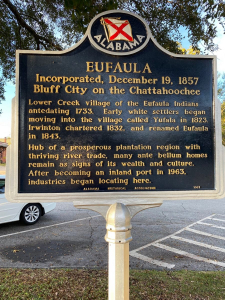
Observations, Photographs, and Reflections from My Too-Brief Hike
I parked at the southern end of the Yoholo Micco Trail, which the sign indicated reached three miles to the northern end of Eufaula. I regretted not having the luxury of time to hike its length. Instead, I may have covered three-quarters of a mile to my time-dictated turn-around.
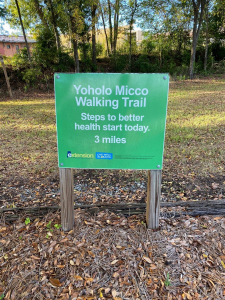
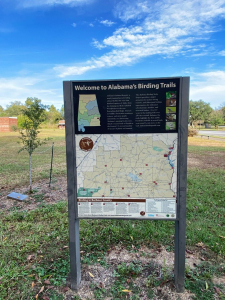
Dozens of memorial trees commemorate loved ones and citizens for whom shade will bless future hikers. There are many ways that Nature enthusiasts can touch the future…extending their Earth stewardship beyond their fleeting existence. Workout stations lined the trail hinting at an objective to increase citizens health and fitness.
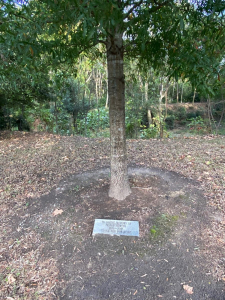
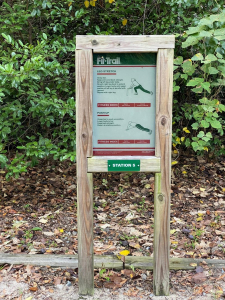
I admit to finding some level of visual appreciation for the flowing mats of kudzu, a cursed invasive of the southland. A working vine of the early-to-mid 20th century, imported from Asia to control rampant erosion, kudzu is the bane of some southern landscapes, where it threatens to take over fields, farms, and forests. Below left it softens the edge, even as it shades and out-competes native vegetation. I did not see the city’s master plan for the trail, yet I am hopeful that a future budget will include funds to eradicate the vine.
What strikes me most about these and other photos is the cerulean sky graced with wispy cirrus, a touch of elegance above the kudzu.
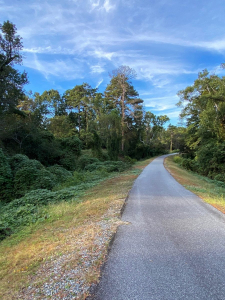
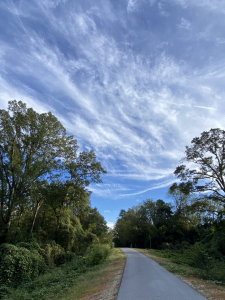
Even a mature pine-tree skeleton added character to the hillside forest lining the trail, it too backed by an over-arching firmament of cirrus.
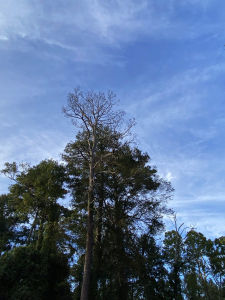
Ah, if only I had brought my bike…I could have covered the entire trail within the available time. However, I’ve learned that I can see far more at my leisurely walking pace than I can at 10-11 mph while casually biking. And far more biking than at Interstate speed. I didn’t long lament my walking, which allowed me to gather more photo images.
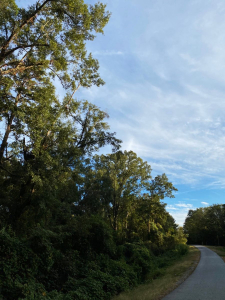
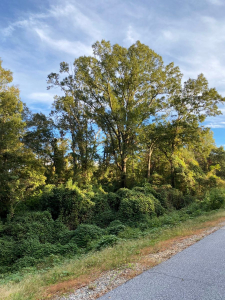
I wondered as I strolled whether this trail emerged from Ron’s efforts with Eufaula community leaders two decades prior. The trail seemed to post-date Ron’s involvement by at least a decade. Perhaps it sprouted from vision-seeds sown from his work. In retrospect, I imagine this railroad grade, choked with kudzu and abandoned. Community vision has since metamorphosed to action…a relic railroad converted to a paved greenway, the foundation for the work that still lies ahead, including ridding the greenway of kudzu.
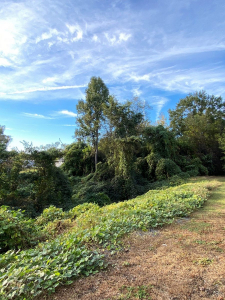
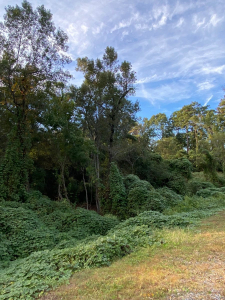
The trail drops from hilly terrain to backwaters of Lake Eufaula…still, the cirrus blesses the evening and reflects on the placid lake surface. I saw lots of walkers, runners, and dog-strollers, and a handful of bikers. The trail is certainly fulfilling its recreational purpose.
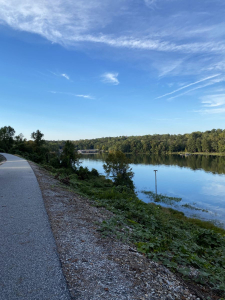
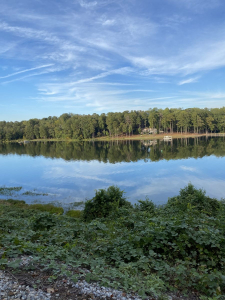
The trail passed by the entrance to a Eufaula yacht club.

The trailside Hopper’s Hollow sign stood as a gateway to a picnic area in a ravine below the trail. Again, I had no time to explore.
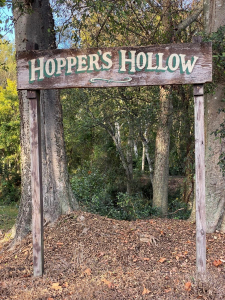

The City of Eufaula is located within an ecologically and recreationally rich area in southeast Alabama. The Eufaula National Wildlife Refuge and Alabama’s Lakepoint State Park lie just six miles to the north. The Lake borders the City, and an arm of it lies adjacent to the trail. Lake Eufaula is a premier bass fishing tournament site. In combination with superb weather with hot, humid summers, and mild winters, the region attracts year-round visitors, recreationists, and Nature enthusiasts.
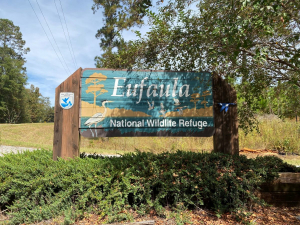
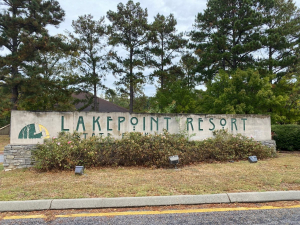
In summary, I found delight in revisiting Eufaula and seeing what I think are tangible outcomes of the efforts Ron invested…and I assisted. Eufaula does indeed seem to be a sustainable community.
The text to this point is mine. I puzzled over how to involve Ron, deciding that I would begin with key excerpts from the 2002 Eufaula Sustainability Report followed by observations, reflections, and photographs from my too-brief hike, and now give you Ron’s current reflections on the project.
Ron Dodson’s Reflections (January 2023)
It was in the early 1970s that I began my involvement in community-based conservation efforts when living in Henderson, Kentucky. My main focus up until then had been to focus on either single species conservation or specific areas of land and water that needed protection. However, it seemed to me that what really needed to be done was to develop a community-wide conservation/education approach that, over time, might cause an attitude change in the entire community at some point.
Those early community-wide efforts garnered enough publicity that I was offered a job with the National Audubon Society in Albany, New York as their regional representative, a position I held for 5 years, until over 30 staff members were let go because of a huge budget shortfall.
So…in 1987, my family and I were living in the Albany, NY area; without a job and a long way from family and the support network that I had built while living in Indiana and Kentucky, I decided to re-start a defunct Audubon organization called The Audubon Society of New York State, which was initially created in 1887 and ceased existence in the 1930s. Since the “single species” focus of the National Audubon Society seemed to lead to a significant budget shortfall, I decided that I should, once again take the “community-wide” approach in re-launching The Audubon Society of New York State. I called this program/venture the Community Conservation Network. I got myself invited to several meetings of New York government and community organizations where I could introduce myself and the idea of working with The Audubon Society of New York State on a community-wide basis, much like I had done in Henderson, Kentucky. It quickly became apparent that this concept was simply not going to take off in the manner that I had envisioned…and I had to figure out how to make some money so I could pay my mortgage!
So…I decided to change my approach by going “door to door” to encourage people who owned and managed land to begin thinking about their property as “sanctuaries.” I envisioned a property as a patch of fabric and that eventually if I got enough “patches” involved, they could be “stitched” together to form a quilt. Eventually, I thought if I could get enough patched stitched together, we could work on a community-wide basis. This conservation/education approach I called The Audubon Cooperative Sanctuary System. The approach took off like a rocket, but I quickly learned that I needed to create specific “programs” within the “system” because I could not convince people who lived or worked on land that was being managed for specific “human-oriented” approaches (farms, schools, golf courses) that they could join the same program that a homeowner could join. Thus, I created several specific programs within the Audubon Cooperative Sanctuary System that were marketed to specific landowner/managers within New York State. The approach was so successful that we began getting interest in joining from property owners/managers in other states. This growing interest led to the creation of a new “brand” for The Audubon Society of New York State, which we called Audubon International. I spent the next couple of decades working with landowners/managers all across America and around the world.
I say all of that as background to a day in the 1990s when I received a telephone call from a person who lived and worked in Eufaula, Alabama who said that they knew about the Audubon Cooperative Sanctuary Program(s), but wondered if they could enroll their entire community in the program?
With that phone call, a light was switched on, and my memories of wanting to work on a community-wide basis were jogged back to life. Thus, I was invited to Eufaula, and over the next few years I made many enjoyable trips to the community and made many friends there, and I hope the community feels that some positive changes were made to the environmental, economic, and social fabric of the community.
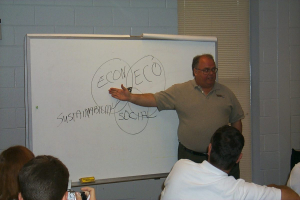
Ron presenting to a community group circa 1998.
I cannot possibly convey the entire story of what transpired during my time working in Eufaula or what has happened since in a blog post…there might be a book in the story actually. I probably learned more from the people in Eufaula than I taught them. I did say to the folks in Eufaula that any “change” within the community must come from within. It simply was not my place to fly into town from New York and point out this or that problem, or come up with this or that “solution,” or say…”just pass this law, and everything will be fixed.”
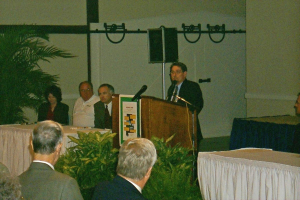
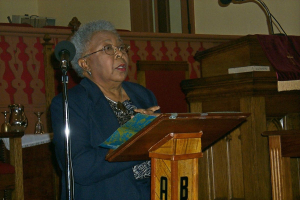
Community sessions discussing the sustainable community concept (Ron at table in white shirt) and a community member offering public input.
I told the community that sustainability is an attitude, not a sign to be hung on a wall. It is a journey, not a destination and it is a journey that doesn’t end. Eufaula is a wonderful place, but it is simply a “place.” It is the people within Eufaula (or any community) that make it a “great place.” People of past generations, the present generation, and future generations will determine the “greatness,” of Eufaula, however.
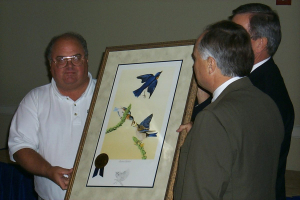
Ron presenting an Audubon Certification Art print to Eufaula’s mayor.
I see the Yoholo Micco Trail that Steve hiked as the kind of Nature-based, sustainability outcome that we sought 25 years ago…if you will, one of the patches to, in aggregate, stitch a community sustainability quilt. I’m pleased that Steve was able to revisit Eufaula, and that he gave me a chance to reflect on my own experiences.
And I, too, am grateful…for Ron’s willingness to contribute to this Post. Ron exemplifies the spirit of passion for informed and responsible Earth Stewardship that I believe is essential for today and across deep time…to sustain all that we hold dear.
Thoughts and Reflections
I offer these observations:
- I believe that embracing a passion for informed and responsible Earth Stewardship is essential for today and across deep time…to sustain all that we hold dear.
- Any community can, and should, enhance natural elements within its bounds..
- A community reveals its essence via its embrace of Nature.
Inhale and absorb Nature’s elixir. May Nature Inspire, Inform, and Reward you!
Note: All blog post images created & photographed by Stephen B. Jones unless otherwise noted. Please circulate images with photo credit: “©2023 Steve Jones, Great Blue Heron LLC. All Rights Reserved.”
Another Note: If you came to this post via a Facebook posting or by an another route, please sign up now (no cost… no obligation) to receive my Blog Post email alerts: http://eepurl.com/cKLJdL
And a Third: I am available for Nature-Inspired Speaking, Writing, and Consulting — contact me at steve.jones.0524@gmail.com
Reminder of my Personal and Professional Purpose, Passion, and Cause
If only more of us viewed our precious environment through the filters I employ. If only my mission and vision could be multiplied untold orders of magnitude:
Mission: Employ writing and speaking to educate, inspire, and enable readers and listeners to understand, appreciate, and enjoy Nature… and accept and practice Earth Stewardship.
Vision:
- People of all ages will pay greater attention to and engage more regularly with Nature… and will accept and practice informed and responsible Earth Stewardship.
- They will see their relationship to our natural world with new eyes… and will understand more clearly their Earth home.
Tagline/Motto: Steve (Great Blue Heron) encourages and seeks a better tomorrow through Nature-Inspired Living!
Steve’s Three Books
I wrote my books Nature Based Leadership (2016), Nature-Inspired Learning and Leading (2017), and Weaned Seals and Snowy Summits: Stories of Passion for Place and Everyday Nature (2019; co-authored with Dr. Jennifer Wilhoit) to encourage all citizens to recognize and appreciate that every lesson for living, learning, serving, and leading is either written indelibly in or is powerfully inspired by Nature.
I began writing books and Posts for several reasons:
- I love hiking and exploring in Nature
- I see images I want to (and do) capture with my trusty iPhone camera
- I enjoy explaining those images — an educator at heart
- I don’t play golf!
- I actually do love writing — it’s the hobby I never needed when my career consumed me
- Judy suggested my writing is in large measure my legacy to our two kids, our five grand kids, and all the unborn generations beyond
- And finally, perhaps my books and Blogs could reach beyond family and touch a few other lives… sow some seeds for the future

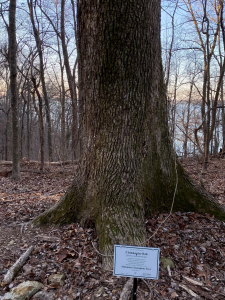
All three of my books (Nature Based Leadership; Nature-Inspired Learning and Leading; Weaned Seals and Snowy Summits) present compilations of personal experiences expressing my (and co-author Dr. Wilhoit for Weaned Seals and Snowy Summits) deep passion for Nature. All three books offer observations and reflections on my relationship to the natural world… and the broader implications for society. Order any and all from your local indie bookstore, or find them on IndieBound or other online sources such as Amazon and LifeRich.

